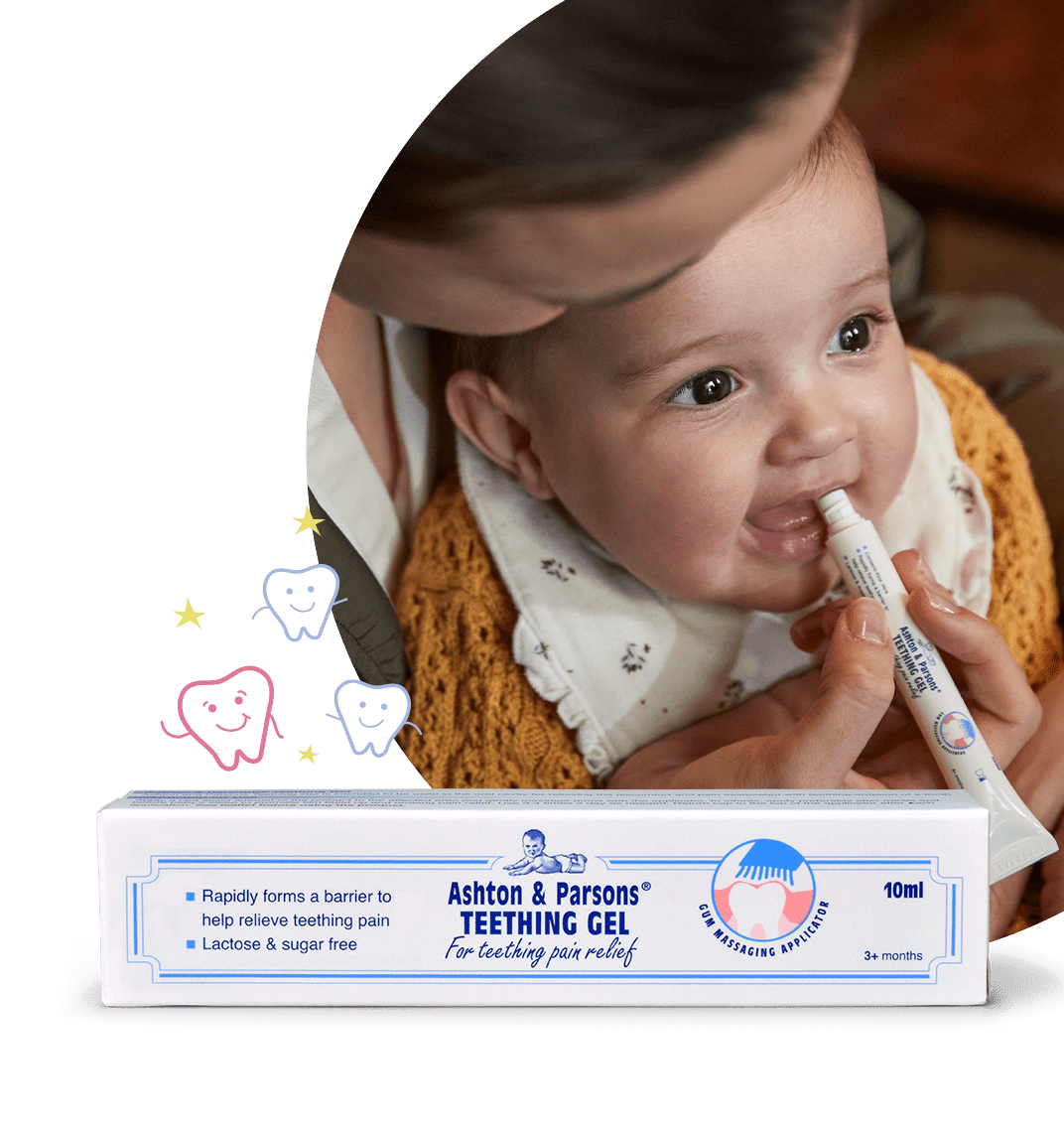Frequently Asked Questions
If you’ve got any questions about Ashton & Parsons, here’s the place to start. And if you can’t see what you’d like to know listed here, you can always get in touch with us here.
FAQs about our Teething Powders
- Q. Are Ashton & Parsons Teething Powders dairy free?
- A. No, each sachet of Ashton & Parsons Teething Powders contains 130mg lactose.
- Q. Can I purchase Ashton & Parsons Teething Powders if I live abroad?
- A. Alliance Pharmaceuticals Limited only hold a licence to distribute Ashton & Parsons Teething Powders in the UK
- Q. At what age can I use Ashton & Parsons Teething Powders on my baby?
- A. Ashton & Parsons Teething Powders can be used from 3 months onwards.
- Q. How do I use Ashton & Parsons Teething Powders?
- A. Take a look at our How to Use Guide here.
- Q. How many sachets can I give to my baby?
- A.Dosage for children 3 - 6 months: Use a teaspoon to give the powder to your infant: half the contents of one sachet in the morning and the other half in the evening. The sachet should be divided in half by emptying half the contents onto the teaspoon and retaining the other half in the sachet. Children 3-6 months: half a sachet dry on the tongue in the morning and half in the evening. Children over 6 months: 1 sachet dry on the tongue morning and night. The dose can be repeated every 1, 2 or 3 hours if necessary. The maximum dose is 6 doses in 24 hours. If symptoms worsen or persist after 7 days of using this product, a doctor or qualified healthcare practitioner should be consulted.
- Q. Can I use Ashton & Parsons Teething Powders if my baby is lactose intolerant?
- A. We would not recommend you use Ashton & Parsons Teething Powders if your child is lactose intolerant as each sachet contains 130mg lactose.
- Q. How does it work?
- A. Ashton & Parsons Teething Powders are a traditional herbal medicinal product used for the symptomatic relief of teething pain and the symptoms associated with teething which are sore and tender gums, flushed cheeks and dribbling based on traditional use only.
- Q. Is it still the same formulation as the original?
- A. Yes. The powder itself remains exactly the same as it has been for the last 150 years.
- Q. What’s the difference between a herbal and a homeopathic remedy?
- A. Following the recent press coverage following the FDA warning on the use of homeopathic teething tablets and gels, Ashton and Parsons encourages education on the difference between traditional herbal remedies and homeopathy to help consumers. Homeopathy is a Complementary or Alternative Medicine (CAM) and different from treatments that are part of conventional Western medicine. It is based on a series of ideas developed in the 1790s by a German doctor, Samuel Hahnemann. A central principle of the Homeopathy is that “like cures like” – that a substance that causes certain symptoms can also help to remove those symptoms. While the practice of homeopathy in the UK is not regulated by law, homeopathic products sold as remedies are regulated by the Medicines and Healthcare products Regulatory Agency (MHRA).
Whereas a Traditional Herbal Remedy (THR) is defined by the World Health Organisation as ‘the sum total of the knowledge, skills, and practices based on the theories, beliefs, and experiences indigenous to different cultures, whether explicable or not, used in the maintenance of health as well as in the prevention, diagnosis, improvement or treatment of physical and mental illness.’
The main difference between herbal and homeopathic products is that with herbal products, increasing the dose would be expected to increase the therapeutic effect, while homeopathic practitioners believe that the more a homeopathic product is diluted, the greater effect the product is expected to have. More detail about the differences can be found here.
THR use is well established and has been used in traditional remedies for over 30 years. They are acknowledged by the national authorities to be well tolerated when used as intended.THRs can make great self-care choices for conditions. Modern herbal medicines are registered by the government regulator in the UK and other European Member States for a wide range of conditions that are suitable for self-medication. THR products will display the logo on product packaging.
Having formal medicines status means that THRs are also of assured quality. The manufacturer is held to account for delivering exactly what the label describes and for monitoring all safety questions that arise. THR’s should therefore be used with the same care and respect as pharmaceutical medicines. Active ingredients refer to ingredients of herbal medicines with therapeutic activity. In herbal medicines where the active ingredients have been identified, the preparation of these medicines should be standardized to contain a defined amount of the active ingredients, if adequate analytical methods are available.
Ashton & Parsons Teething Powders have been used for 150 years. The powders were re categorised as a THR in 2012 and Alliance became a member of the British Herbal Medicines Society (BHMA) in 2013. Ashton & Parsons adheres to the Good Manufacturing Practice (GMP) where the manufacturing process is one of the key steps where quality control is required to ensure quality of medicinal products, including herbal medicines. Each sachet contains powder impregnated with 0.002ml of the active ingredient tincture of Matricaria which is extracted from German Chamomile flower heads.
FAQs about our Teething Gel
- Q. Is Ashton & Parsons Teething Gel dairy free?
- A. Yes, the gel contains no lactose or dairy products.
- Q. Is Ashton & Parsons Teething Gel sugar free?
- A. Yes, the gel contains no sugar.
- Q. Is Ashton & Parsons Teething Gel alcohol free?
- A. Yes, the gel contains no alcohol.
- Q. Is Ashton & Parsons Teething Gel local-anaesthetic free?
- A. Yes, the gel contains no local-anaesthetic.
- Q. Can I purchase Ashton & Parsons Teething Gel if I live abroad?
- A. Alliance Pharmaceuticals Limited only hold a licence to distribute Ashton & Parsons Teething Gel in the UK.
- Q. At what age can I use Ashton & Parsons Teething Gel on my baby?
- A. Ashton & Parsons Teething Gel can be used from 3 months.
- Q. How do I use Ashton & Parsons Teething Gel?
- A. Take a look at our how to use guide here.
- Q. How many times can I use Ashton & Parsons Teething Gel?
- A. Apply a pea sized amount of the product, use 3-4 times a day as needed.
- Q. Where can I buy Ashton & Parsons Teething Gel?
- A. Take a look at our stockists here.
- Q. How does it work?
- A. Ashton & Parsons Teething Gel rapidly forms a protective barrier on sore and tender gums, to help soothe the symptoms associated with teething. The applicator also gently massages the gums, for additional relief.
- Q. What are the ingredients of Ashton & Parsons Teething Gel?
- A. Aqua, polyvinylpyrrolidone (PVP), maltodextrin, propylene glycol, PEG-40 hydrogenated castor oil, aloe barbadensis, xanthan gum, banana flavour, potassium sorbate, sodium benzoate, disodium EDTA, sodium hyaluronate, xylitol, cetylpyridinium chloride, glycyrrhetinic acid, crocus sativus.





